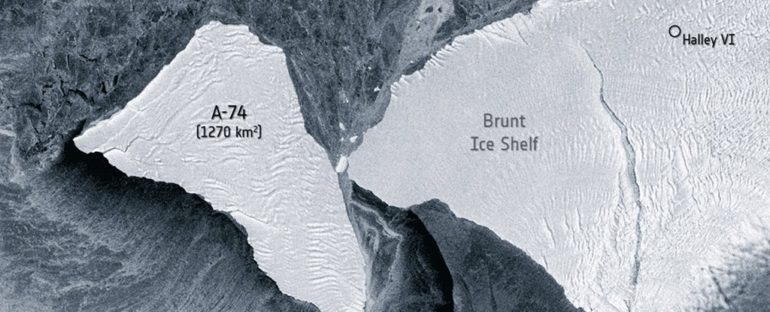With rising temperatures and significant climate shifts predicted for Antarctica in the years to come, the icy continent could use a break. Well, now it’s had one, as it just had a near miss with a giant iceberg double the size of Chicago.
The iceberg in question is A-74. Having originally been attached to Antarctica, it broke out into open waters back in February, as a result of a major crack that ripped through the Brunt ice shelf over the space of just a few months.
Then, in the past six months, A-74 loitered close to its original position, largely due to the prevailing ocean currents in the area; but in early August, strong easterly winds were responsible for the iceberg moving southwards and spinning around, changing its course.
Along the way, it clipped the edge of the Brunt ice shelf where it was born, in what the European Space Agency (ESA) has described as a “minor impact”.
If it had been a major one, another gigantic piece of Brunt might have broken free.
“The nose-shaped piece of the ice shelf, which is even larger than A-74, remains connected to the Brunt Ice Shelf, but barely,” says geophysicist Mark Drinkwater from the ESA.
“If the berg had collided more violently with this piece, it could have accelerated the fracture of the remaining ice bridge, causing it to break away. We will continue to routinely monitor the situation using Sentinel satellite imagery.”
That satellite imagery is crucial for figuring out what’s happening to Antarctica on the biggest scales: the integrated radar instruments are able to map the remotest regions day or night, summer or winter, in any kind of weather conditions.
A-74 is 1,270 square kilometers (490 square miles) in size, one of the largest free-floating icebergs in the world (the largest is the iceberg A-76 which calved earlier this year and covers 4,320 square kilometers).
Had A-74 really made a hit on the Brent ice shelf, a new iceberg around 1,700 square kilometers (656 square miles) in size could have been created, according to the ESA.
That’s because of the other cracks that have put the western edge of the Brunt ice shelf in a precarious position – Chasm 1 stretching up from the south and the Halloween crack to the north that runs from west to east.
Meanwhile, the shifting ice is keeping researchers on their toes: the Halley VI research station was moved by 20 kilometers (12.4 miles) in 2017 to make it safer from the ice shelf calving that scientists knew was likely to happen.
“Halley is made up of eight interlinked pods built on skis which allows the pods to be easily moved in case of unstable ice or new chasms forming on the ice shelf,” explains the ESA in a statement.
Late last year, another free-floating iceberg called A68a came dangerously close to South Georgia Island in the southern Atlantic Ocean, home to millions of penguins, sea lions, albatrosses, and petrels.
As the climate crisis continues to unfold around the globe, scientists need all the information they can get on how Antarctic ecosystems may fracture in the coming years. For now, the icebergs will keep coming.



